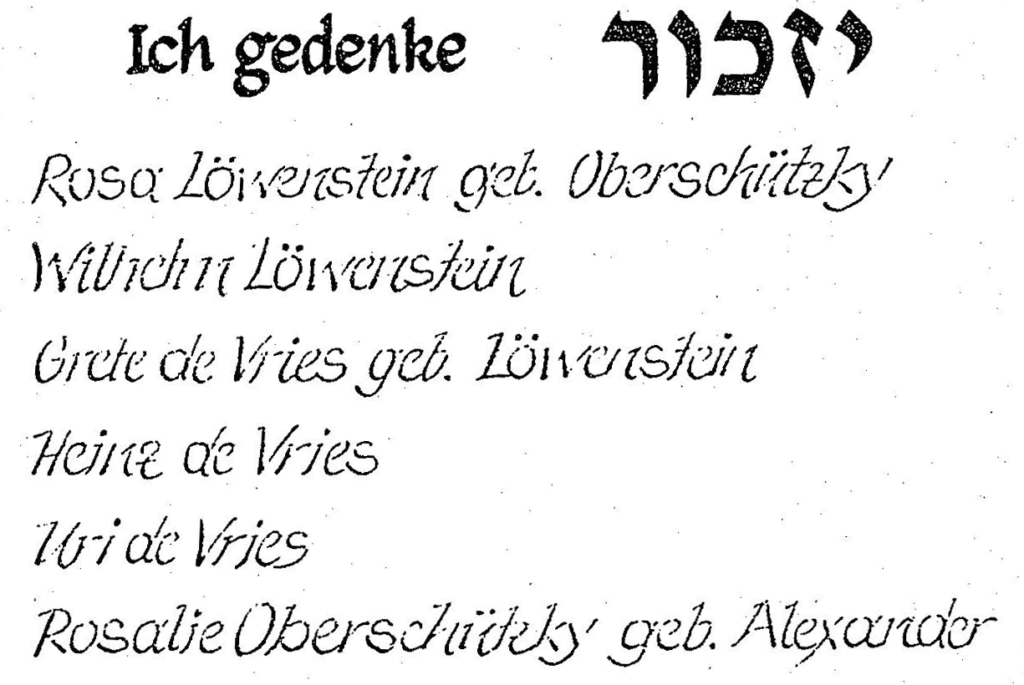In the night from 9 November to 10 November 1938, Nazis all over Germany and Austria burned down synagogues and vandalized Jewish homes, schools, and shops. This night was called “Kristallnacht” (Crystal night or night of broken glass) and is now usually referred to “Pogromnacht” or “Novemberprogrom” (November Pogrom). More than 30,000 Jewish men were arrested in the wake of this Pogrom, a lot of them taken to concentration camps, and 91 Jews were murdered. {{{Yad Vashem, The November Pogrom (https://www.yadvashem.org/yv/en/exhibitions/kristallnacht/index.asp : accessed 8 Nov 2021).}}}
Wilhelm Löwenstein was one of the 319 Jewish men arrested on 10 November 1938 in Essen. The Gestapo took the arrested men to the detention center Haumannshof which was located behind the district court at Zweigertstrasse.{{{Stadt Essen,
Pogromnacht (https://historischesportal.essen.de/startseite_7/ereignisse_1/pogromnacht.de.html
: accessed 8 Nov 2021).}}} {{{Schlauer statt Rechts, Landgericht und Gefängnis in der Zweigertstraße (http://www.schlauer-statt-rechts-essen.de/?tag=gestapo : accessed 8 Nov 2021).}}}

His daughter Inge said that her father, who had been a fun-loving man, suffered from general weakness and fainting spells after he was released from his two-week ordeal in prison and was never the same. {{{Personal correspondence}}}
Wilhelm Löwenstein was born 28 December 1882 in Hameln as the son of Moses and Sara Löwenstein. He married Paula Levy and on 20 July 1913 daughter Grete was born in Paderborn. Paula died when Grete was only 2 years old.
In 1919, Wilhelm married his second wife, Rosa (Rosalie) Oberschützky. She was born 9 June 1887 in Hannover to Rabbi Samuel Oberschützky and Rosalie Alexander. Wilhelm and Rosalie Löwenstein welcomed daughter Inge on 6 January 1920 in Hameln.
The small family moved to Essen in 1929/30. Wilhelm was the local agent in Essen for the silk weavers A. Wellenbrink & Sohn in Gütersloh.
Rabbi Samuel Oberschütkzy had passed away in 1931 and Rosalie Oberschützky had lived with her younger daughter Frieda Isenberg in Osnabrück. Frieda moved to the Netherlands in 1933 and Rosalie joined the Löwensteins in Essen. {{{https://geo.osnabrueck.de/allgemein/PDF/Stolpersteine_Pressespiegel/2009-11-21_Nazis_verfogten_sie_bis_nach_Amsterdam.pdf}}}
Inge remembered that her grandmother loved excursions with their car. She also remembers spending time talking with her mother in the bay window in their apartment.
In 1939 daughter Grete married Heinz de Vries, born 14 January 1912 in Gelsenkirchen. He moved to Essen and on 7 January 1940 son Uri de Vries was born.
Wilhelm Löwenstein had fought in the 17th Infantry Regiment and had been awarded the Honor Cross of the World War (Frontkämpferehrenkreuz){{{https://en.wikipedia.org/wiki/The_Honour_Cross_of_the_World_War_1914/1918}}}. For a long time he believed, that they would not be affected by the persecution by the Nazis. However, In October 1938, he and probably Grete were fired from their job and in November he was arrested. His world was shattered.
Wilhelm had applied for a travel permit to travel to the USA or Chile, but the permit was cancelled last minute.
During his imprisonment Wilhelm had met someone, who promised to help his daughter Inge leave to England. She wanted to stay with her family, but her father told her, that if she wouldn’t go, nobody had a chance. And he was right. She was the only survivor.

Grete, Heinz and Uri de Vries were deported to Izbica on 22 April 1942. {{{Bundearchiv, Memorial Book (https://www.bundesarchiv.de/gedenkbuch/en851861 : accessed 8 Nov 2021).}}} {{{Bundearchiv, Memorial Book (https://www.bundesarchiv.de/gedenkbuch/en996149 : accessed 8 Nov 2021).}}} {{{Bundearchiv, Memorial Book (https://www.bundesarchiv.de/gedenkbuch/en851883 : accessed 8 Nov 2021).}}}
Rosa and Wilhelm Löwenstein were deported to Sobibor on 15 June 1942.{{{Bundearchiv, Memorial Book (https://www.bundesarchiv.de/gedenkbuch/en920001 : accessed 8 Nov 2021).}}} {{{Bundearchiv, Memorial Book (https://www.bundesarchiv.de/gedenkbuch/en919867 : accessed 8 Nov 2021).}}}
Rosalie Oberschützky was deported to Theresienstadt on 21 July 1942.{{{Bundearchiv, Memorial Book (https://www.bundesarchiv.de/gedenkbuch/en938288 : accessed 8 Nov 2021).}}}
Inge Löwenstein passed away on 18 February 2009 in England. {{{Sutton / Croydon Guardian, Inge Lowenstein (https://www.yourlocalguardian.co.uk/news/4193945.inge-lowenstein/ : accessed 8 Nov 2021).}}}
Gedenkbuchprojekt – Memory Book Project
Between 1985 and 2006 the Old Synagogue Essen had a project called “Gedenkbuchprojekt” (Memory Book Project) in which individuals, groups or school classes would research the life of a Jewish family or person from Essen, often involving contact to surviving family members. Almost 400 memory stories were created during this time. These pages are a great resource not just for names and dates but to get a glimpse of the lives of Jews in Essen told through the eyes of survivors.
When I was in high school, my class was in contact with Inge Löwenstein and we wrote the memory page for her family.
The original pages are on exhibit in the Old Synagogue Essen. A transcript can be downloaded here (however, it contains a lot of errors and some omissions).

